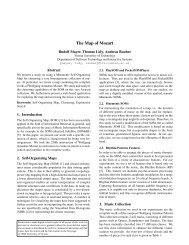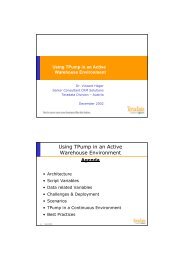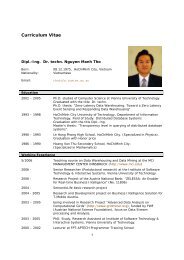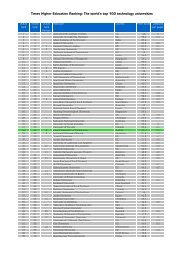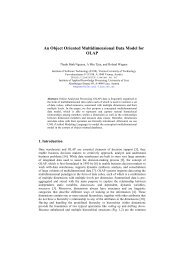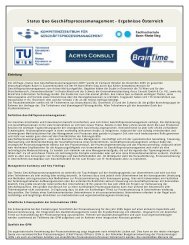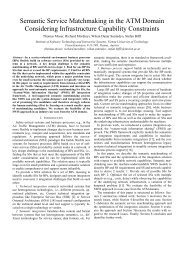Using Psycho-Acoustic Models and Self-Organizing Maps to Create ...
Using Psycho-Acoustic Models and Self-Organizing Maps to Create ...
Using Psycho-Acoustic Models and Self-Organizing Maps to Create ...
You also want an ePaper? Increase the reach of your titles
YUMPU automatically turns print PDFs into web optimized ePapers that Google loves.
“<br />
‘<br />
‘<br />
‡<br />
‘<br />
<strong>Using</strong> <strong>Psycho</strong>-<strong>Acoustic</strong> <strong>Models</strong> <strong>and</strong> ¢¡¤£¦¥ <strong>to</strong> create a Hierarchical Structuring of Music<br />
layer 0<br />
æ n<br />
layer 1<br />
x(t)<br />
m(t) m(t+1) c<br />
c<br />
c<br />
layer 2<br />
Input Space<br />
Output Space<br />
layer 3<br />
‡S˜.š<br />
˜=‹ £<br />
‹ ‡šF‡š4‰ ’v˜4£FŒ"¡Ø•=Œ"<br />
†J‡S‰.ŠF‹Œ<br />
Œ"<br />
ŠF‹Œ<br />
²4jñ¤ò¦ó·ôˆõö ‹9 ¼<br />
'—F‘<br />
†ˆ‡y‰.ŠF‹Œ<br />
±F^Ž<br />
In combining these principles of self-organizing map training, we<br />
may write the learning rule as given in Expression (2), with ã representing<br />
the time-varying learning-rate, å ÛLÎ representing the timevarying<br />
neighborhood-kernel, Ó representing the currently presented<br />
input pattern, <strong>and</strong> ÍqÎ denoting the model vec<strong>to</strong>r assigned <strong>to</strong> unit Ì .<br />
A simple graphical representation of a self-organizing map’s architecture<br />
<strong>and</strong> its learning process is provided in Figure 4. In this<br />
Í Î ÔAÒ5éÄâ9ÕÜÄÍ Î ÔAÒÕ4é ã ÔAÒÕOêå ÛLÎ ÔAÒCÕ êRëÓOÔAÒÕOÚfÍ Î ÔAÒÕ7ì<br />
figure the output space consists of a square of 36 units, depicted<br />
as circles, forming a grid of íºî¦í units. One input vec<strong>to</strong>r ÓOÔAÒCÕ is<br />
r<strong>and</strong>omly chosen <strong>and</strong> mapped on<strong>to</strong> the grid of output units. The<br />
winner Ö showing the highest activation is determined. Consider the<br />
winner being the unit depicted as the black unit labeled in the figure.<br />
The model vec<strong>to</strong>r of the winner, ÍqÛÔAÒÕ , is now moved <strong>to</strong>wards<br />
the current input vec<strong>to</strong>r. This movement is symbolized in the input<br />
space in Figure 4. As a consequence of the adaptation, unit Ö will<br />
produce an even higher activation with respect <strong>to</strong> the input pattern<br />
Ó at the next learning iteration, Ò.éïâ , because the unit’s model vec<strong>to</strong>r,<br />
ÍqÛ9ÔAÒFéðâÕ , is now nearer <strong>to</strong> the input pattern Ó in terms of the<br />
input space. Apart from the winner, adaptation is performed with<br />
neighboring units, <strong>to</strong>o. Units that are subject <strong>to</strong> adaptation are depicted<br />
as shaded units in the figure. The shading of the various units<br />
corresponds <strong>to</strong> the amount of adaptation, <strong>and</strong> thus, <strong>to</strong> the spatial<br />
width of the neighborhood-kernel. Generally, units in close vicinity<br />
of the winner are adapted more strongly, <strong>and</strong> consequently, they are<br />
depicted with a darker shade in the figure.<br />
Being a decidedly stable <strong>and</strong> flexible model, `5aNb the has been employed<br />
in a wide range of applications, ranging from financial data<br />
analysis, via medical data analysis, <strong>to</strong> time series prediction, industrial<br />
control, <strong>and</strong> many more [5, 13, 32]. It basically offers itself<br />
<strong>to</strong> the organization <strong>and</strong> interactive exploration of high-dimensional<br />
data spaces. One of its most prominent application areas is the organization<br />
of large text archives [15, 19, 29], which, due <strong>to</strong> numerous<br />
computational optimizations <strong>and</strong> shortcuts that are possible in this<br />
NN model, scale up <strong>to</strong> millions of documents [11, 14].<br />
However, due <strong>to</strong> its <strong>to</strong>pological characteristics, the `FaNb<br />
Ô*§Õ<br />
not only<br />
serves as the basis for interactive exploration, but may also be used as<br />
an index structure <strong>to</strong> high-dimensional databases, facilitating scalable<br />
proximity searches. Reports on a combination of `5aNbË <strong>and</strong><br />
R*-trees as an index <strong>to</strong> image databases have been reported, for<br />
example, in [20, 21], whereas an index tree based on the `FaNb<br />
is reported in [36]. Thus, `5aNb the combines <strong>and</strong> offers itself in<br />
a convenient way both for interactive exploration, as well as for<br />
the indexing <strong>and</strong> retrieval, of information represented in the form<br />
of high-dimensional feature spaces, where exact matches are either<br />
impossible due <strong>to</strong> the fuzzy nature of data representation or<br />
the respective type of query, or at least computationally prohibitive,<br />
making them particularly suitable for image or music databases.<br />
4.2 The GHSOM<br />
The key idea of the m \ n0ygQoxp{*_ \ \ hQ©`=_$©r$ea \ oRgst$AgQô bvw [6]<br />
is <strong>to</strong> use a hierarchical structure of multiple layers, where each layer<br />
consists of a number of `5aNbË independent . `Fa0b One is used at<br />
the first layer of the hierarchy, representing the respective data in<br />
more detail. For every unit in this map `FaNb a might be added <strong>to</strong><br />
the next layer of the hierarchy. This principle is repeated with the<br />
third <strong>and</strong> any further layers of mNp{`FaNb the .<br />
Since one of the shortcomings `FaNb of usage is its fixed network<br />
architecture we rather use an incrementally growing version of the<br />
. This relieves us from the burden of predefining the network’s<br />
`5aNb<br />
size which is rather determined during the unsupervised training<br />
process. We start with a layer 0, which consists of only one single<br />
unit. The weight vec<strong>to</strong>r of this unit is initialized as the average of<br />
all input data. The training process basically starts with a small map<br />
of, § îj§ say, units in layer 1, which is self-organized according <strong>to</strong><br />
the `Fa0b<br />
st<strong>and</strong>ard training algorithm.<br />
This training process is repeated for a fixed number ÷ of training<br />
iterations. Ever after ÷ training iterations the unit with the largest<br />
deviation between its weight vec<strong>to</strong>r <strong>and</strong> the input vec<strong>to</strong>rs represented<br />
by this very unit is selected as the error unit. In between the error unit<br />
<strong>and</strong> its most dissimilar neighbor in terms of the input space either a<br />
new row or a new column of units is inserted. The weight vec<strong>to</strong>rs<br />
of these new units are initialized as the average of their neighbors.<br />
An obvious criterion <strong>to</strong> guide the training process is ø [ g¢~9e<br />
the<br />
\:\ \¢ù Î , calculated as the sum of the distances between the<br />
~gï_<br />
weight vec<strong>to</strong>r of a Ì unit <strong>and</strong> the input vec<strong>to</strong>rs mapped on<strong>to</strong> this unit.<br />
It is used <strong>to</strong> evaluate the mapping quality of `5aNb a based on<br />
¬<br />
the<br />
[ gs~t~g¤_ \:\ \ (b®û ]<br />
) of all units in the map. A map<br />
_Cgúø<br />
grows until b¤û ]<br />
its falls below a certain ü ¨<br />
fraction of the Î of<br />
the unit ù in the preceding layer of the hierarchy. Thus, the map now<br />
Ì<br />
represents the data of the higher layer Ì unit in more detail.<br />
As outlined above the initial architecture of the mNp{`Fa0b<br />
consists<br />
of `FaNb one . This architecture is exp<strong>and</strong>ed by another layer in case<br />
of dissimilar input data being mapped on a particular unit. These<br />
units are identified by a rather high quantization error Î which is<br />
above a threshold ù . This threshold basically indicates the desired<br />
ü9ý<br />
granularity level of data representation as a fraction of the initial<br />
quantization error at layer 0. In such a case, a new map will be<br />
added <strong>to</strong> the hierarchy <strong>and</strong> the input data mapped on the respective<br />
higher layer unit are self-organized in this new map, which again<br />
grows until b®û ]<br />
its is reduced <strong>to</strong> a ü ¨<br />
fraction of the respective<br />
higher layer unit’s quantization error Î . Note that this does not<br />
necessarily lead <strong>to</strong> a balanced hierarchy. The depth of the hierarchy<br />
will rather reflect the diversity in input data distribution which should<br />
be expected in real-world data collections. Depending on the desired<br />
ù ü ¨<br />
fraction b®û ]<br />
of reduction we may end up with either a very deep<br />
hierarchy with small maps, a flat structure with large maps, or – in<br />
the extreme case – only one large map. The growth of the hierarchy<br />
is terminated when no further units are available for expansion.<br />
Àèç





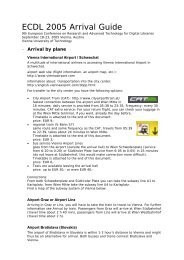
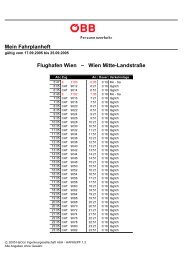
![Informationsvisualisierung [WS0708 | 01 ]](https://img.yumpu.com/22537403/1/190x143/informationsvisualisierung-ws0708-01-.jpg?quality=85)
